Tom Schulz and Daniel De Wit aren’t your ordinary concrete contractors.
They’re not really your ordinary anything.
The two members of Ennis Art (Tom is the CEO and Daniel is the design associate) provide such a unique combination of skills and experience that it defies simple categorization, and their prowess is one that’s a rare find across the nation.
The uncle-and-nephew team uses a special blend of art and science to produce fine art installations on finished concrete floors, particularly designs of the labyrinth variety.
That’s what led the two to Lawrence, Kan., in the summer of 2018. Their services were hired by the leadership of the community’s Peace Mennonite Church, which had recently undergone an addition and renovation.
Defining the scope
Before construction began in April 2018 to double the building’s square footage, the church’s building committee discussed what it wanted out of the floors.
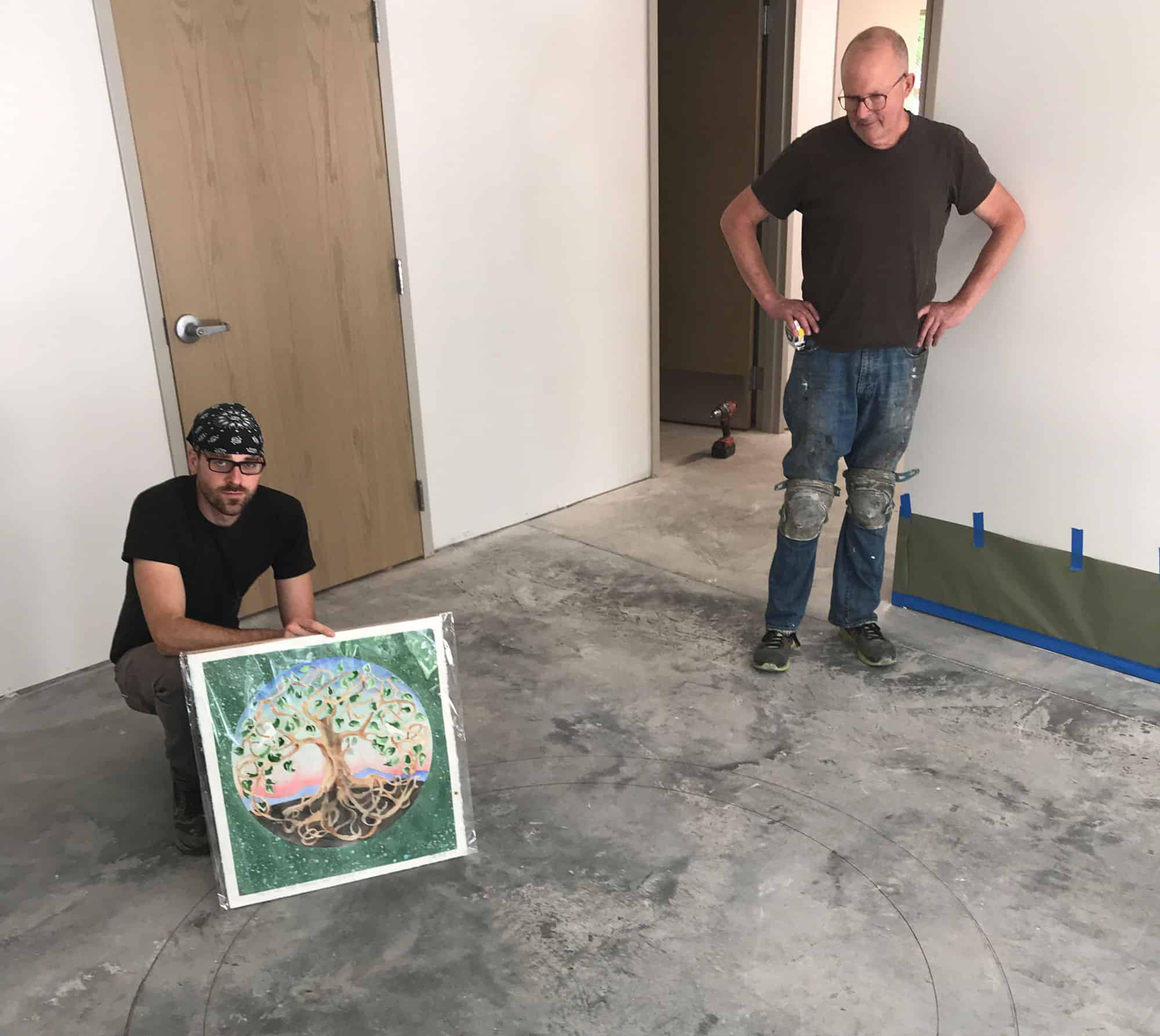
“Concrete floors were something that we were interested in for environmental reasons,” said Joanna Harader, pastor of the Peace Mennonite Church in Lawrence. “Concrete is just a lot more environmentally friendly in a lot of ways, but we were also really concerned about the aesthetics. We wanted it to still look nice.”
A member of the building committee found a video of stained concrete, which led to the realization that their floors could be much more interesting than just polished concrete.
“I asked if we could do a labyrinth, and that’s how we got connected with Ennis Art, because Tom Schulz is one of the very few people in the country who does labyrinth installations in concrete,” Harader said.
Walking the labyrinth is an ancient spiritual practice, one that goes beyond Christian traditions but has been prominent in Christian practices since Medieval times, she said.
“No indoor labyrinths exist in the area, so this is something we thought we could do to share with the larger community too and invite people in.”
The church also decided on a Tree of Life design for the entryway, a nod to the Bible’s parable of the mustard seed and birds resting in tree branches. “We asked Tom to make sure the birds are there in the trees,” Harader said.
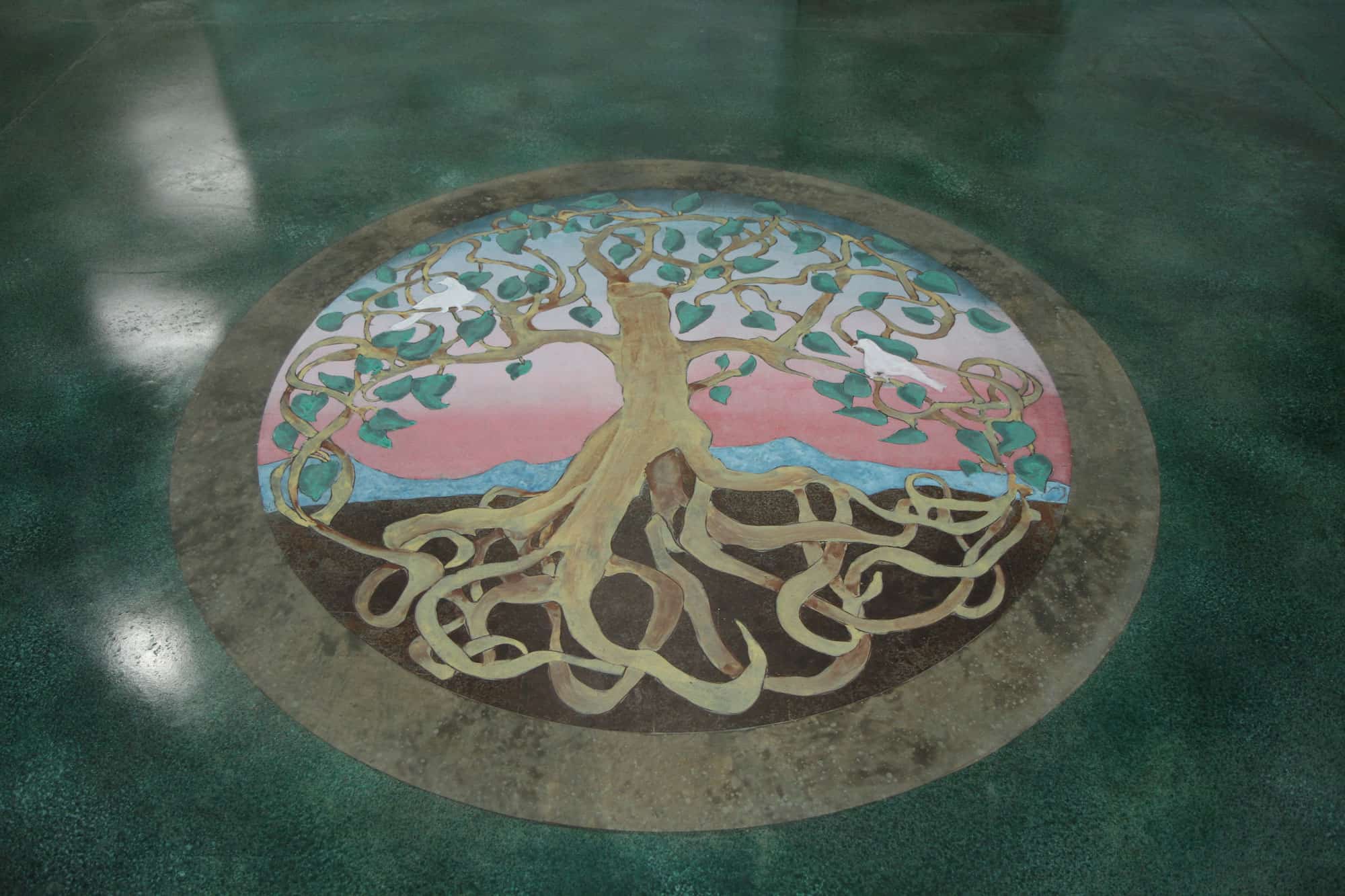
Both designs were selected due to their special connection to the congregation and general appeal to the public at large.
“Like the labyrinth, the Tree of Life is a spiritual image but it’s not an exclusive image,” Harader said. “If we have people use the building who aren’t Christian, it’s not an image that’s exclusionary or off-putting to other groups.”
As the church’s leadership entered discussions with Ennis Art about creating and executing these designs, the scope of work quickly grew to include finishing and coloring the building’s entire concrete floor.
That involved a challenge of one uniform aesthetic on essentially four different types of pours. “The original concrete floor, which was covered with VCT. There were some patches, there was a new pour, and kind of the merging in between those,” De Wit said.
Finding a solution for the varying pours and conditions took some experimentation, but that was nothing new to the team. They had previously worked with PROSOCO’s Consolideck products for an intricate watershed design on the Hitchcock Center for the Environment, a Living Building Challenge project.
Doing their homework
Prior to arriving on any job site, the Ennis Art duo spends hours in their Asheville shop to determine precise formulas according to what the owners want out of their floors.
“We’re always experimenting and making samples,” De Wit said. “We do a lot of our investigations in our workshop on cast pieces that we make specifically for test purposes. So developing the different samples informed us on how we can approach new installations, but we’re always having to change things slightly with this floor in particular. Certain parts were much darker than others. Certain parts were more open or closed depending on what existed in the concrete before we got here. Sometimes we have to make artistic decisions that are variations on the formula so that the final product looks closer to the actual sample.”
Watch: Ennis Art’s short video of workshop experimentation
In this case, the church wanted an organic, green, mottled effect throughout the entire building. Schulz and De Wit would need a system of products to produce a uniform appearance and sheen on a variety of floor conditions.
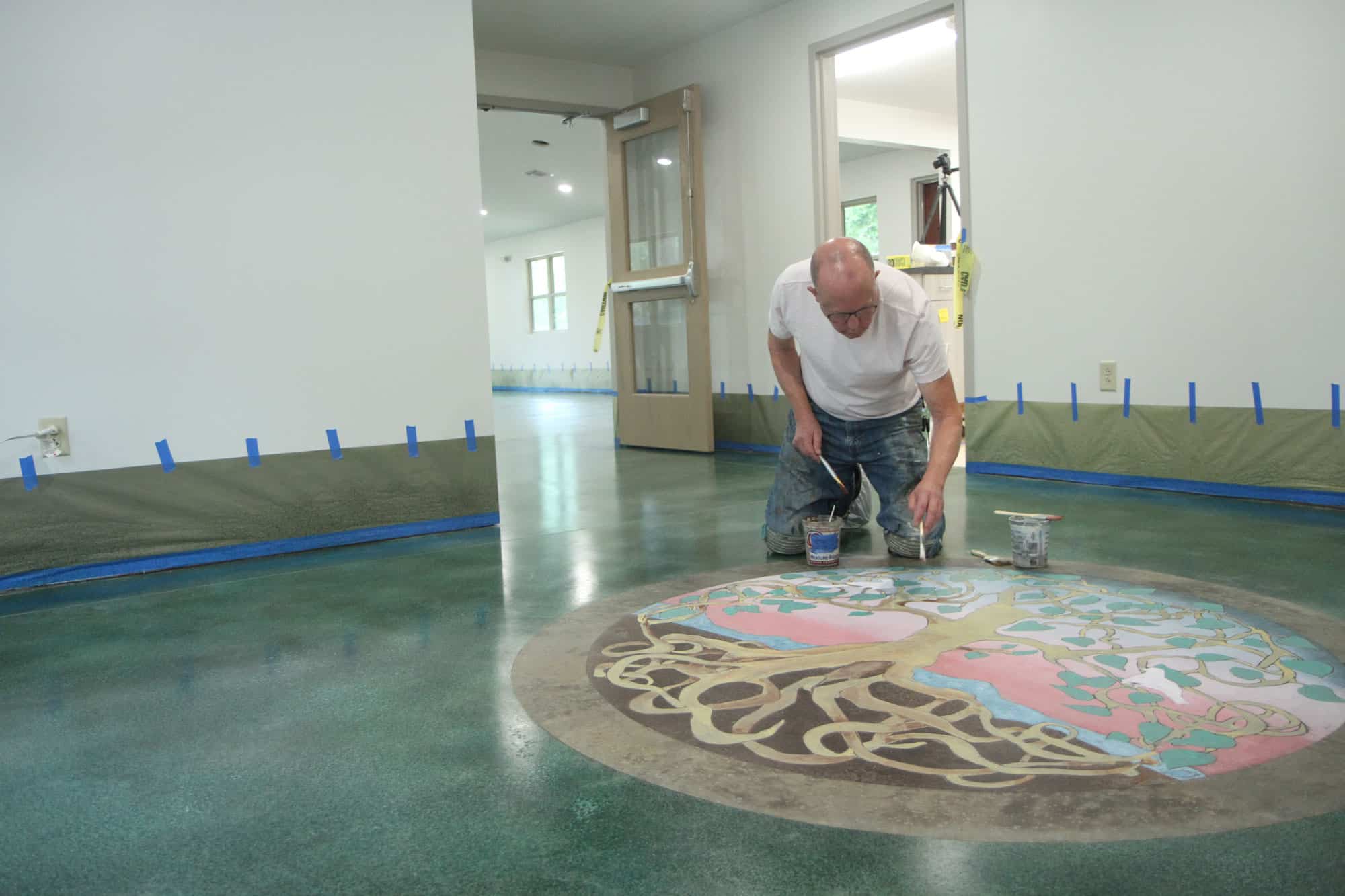
“We thought that the PROSOCO products would be great because they have an opaqueness that would allow us to equalize out some of those discrepancies from the different old and new pours, and then also where different material had been glued down or applied to the floor back in the day,” De Wit said.
Time for more testing
Still more trial-and-error awaited Schulz and De Wit once they arrived on site in Lawrence. Neither one really knew exactly what combination of products and processes would work until they saw the floor in person.
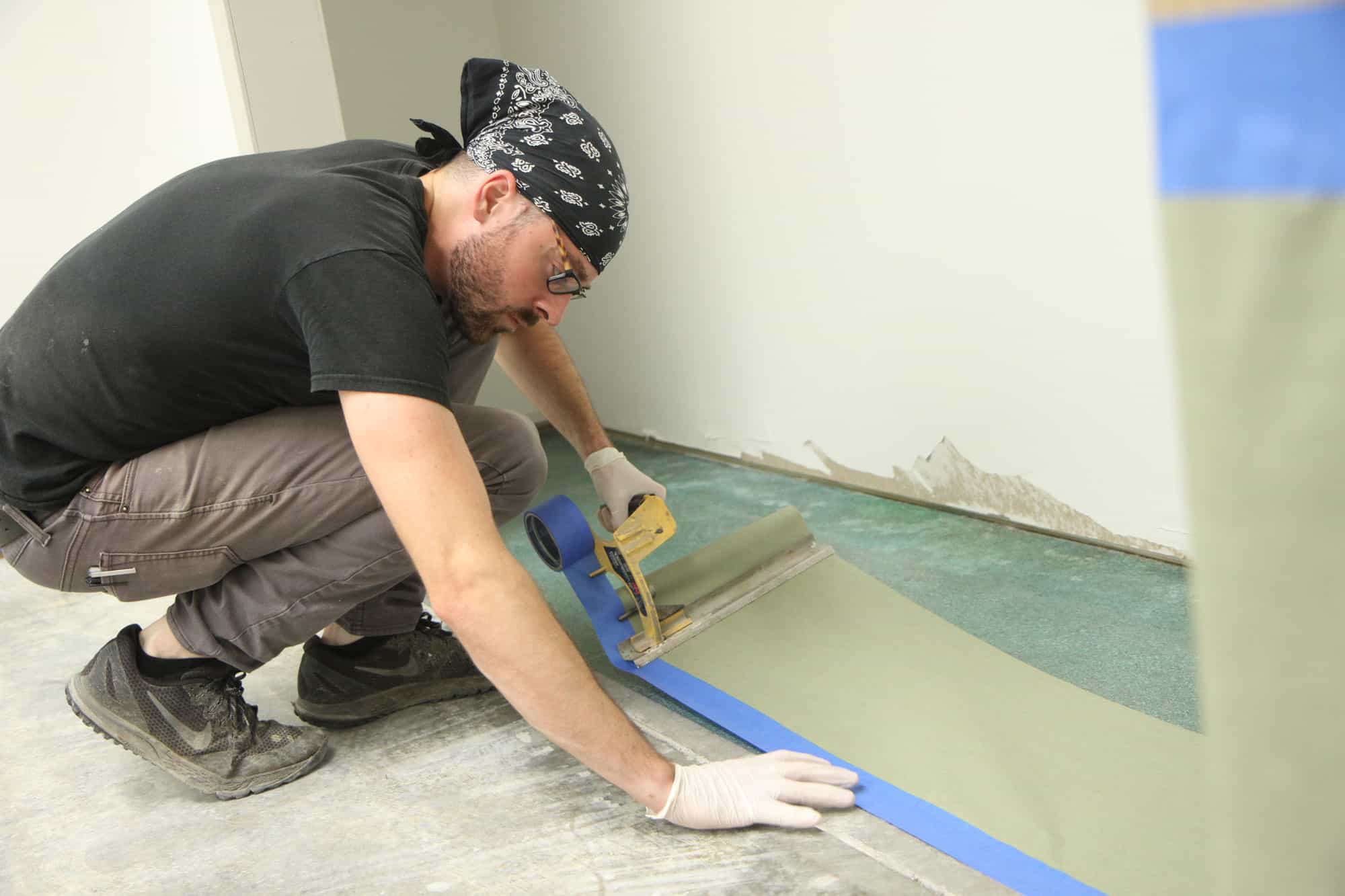
They arrived on site to discover their first challenge – a significant amount of adhesive left on the concrete after the VCT was removed. Here’s the sequence that followed:
- To allow a stripping agent to reach the adhesive, they cleaned the whole floor with 2010 All Surface Cleaner.
- Once the floors were cleaned and wet-vacuumed, they tried Wax & Cure Remover, which De Wit said worked but not quite well enough. “There was a lot of intense glue and mastic that was left over from the tile,” De Wit said. “It was really cooked in and penetrated deeply into the surface.”
- They then tried Cure & Seal Remover, which did the trick. “We used that throughout all of the historic parts of the building where the tile was applied.”
- After the floor was stripped, De Wit and Schulz used a combination of hand-scrapers and abrasive buffing pads, and wet-vacuumed up the residual sludge using water and 2010.
- SafEtch was used to open up the concrete's pores.
- And finally, 2010 was applied again at a very mild dilution to remove the residue and leave the floor in its most clean and open state.
“From there, it was ready to apply the ColorHard,” De Wit said.
To achieve the desired look, the team used four different shades of ColorHard, mixed with LS densifier/hardener, at varying dilutions.
- Copper Patina: This color is similar to the Statue of Liberty, De Wit said. Used at 30:1 dilution.
- White: To give the color some nice highlights at a 40:1 dilution.
- Emerald: Diluted at 60:1, or exactly half-strength.
- Serpentine: Used last to “settle everything in and mute it down.” Used at regular strength, 30:1 dilution.
“All four of these layers were applied with a one-gallon tank sprayer,” De Wit said. “Sometimes we used a textured roller to make a more uniform mottled effect.”
That produced a controlled but still ancient, mottled and organic appearance.
“…and then we finally applied two coats of PolishGuard which was then burnished to bring up the total shine and to give it a cohesive final coated layer.”
All the trial-and-error “is very site-specific, in-the-moment, conscious artistic decisions to get a final, consistent result,” De Wit said.
Art down to a science
The work that Schulz and De Wit do is no doubt art. But it isn’t as simple as oil paints on a canvas.
Their work is often not even as simple as applying a stain to a concrete floor. Because every concrete floor is different, with varying factors – conditions, blemishes, previous treatments, desired performance and aesthetic -- that affect their artistic efforts.
They mix, they measure, they test meticulously, they document, they experiment, they frequently start over again, and they execute.
As purveyors of artistic designs on a chemically reactive surface like concrete, Schulz and De Wit have long understood the intricate balance between their creative endeavors and the chemistry of their substrates and products.
“Tom’s a fine artist and painter as well as having a background as a contractor,” said De Wit of his uncle. “That informs how we approach our installations. He has developed a way of using watercolors to reflect the colors available in the ColorHard pigment charts, and now he’s able to make a representation of the PROSOCO products with the watercolors, which is how he develops the designs.”
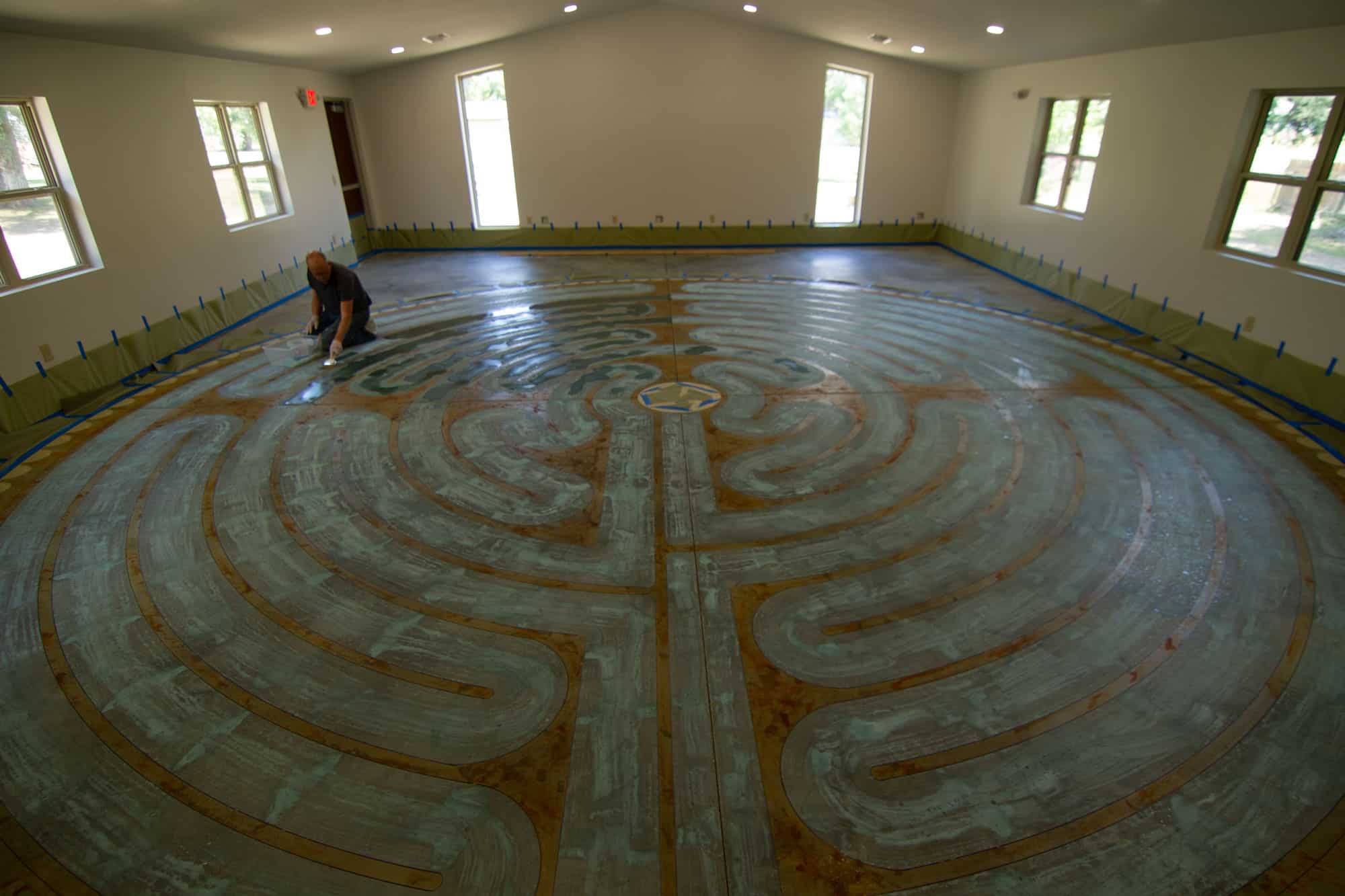
Those designs are in high demand as more people are turning on to the aesthetic effect of concrete artwork.
Ennis Art has been hired to do vertical surfaces, horizontal surfaces, art installations, cast pieces, labyrinths and more.
The pair recently completed a labyrinth in an oncology center at a hospital in Greenville, N.C.
“As people are becoming more aware of the benefits of a meditative walking path and meditation in general, we’re getting more work that is related to that kind of interactive healing,” De Wit said.
In Lawrence, the Peace Mennonite Church plans to make the labyrinth available for use by the public on the first Friday of each month.
“It’s a flexible space and a worship space,” Harader said. “On Sunday mornings, it’s not set up in a way that people can walk it, but a lot of times that space will be open and people can use it for the meditative walking.”
At the renovated church’s open house in mid-August, more than 100 people came through to see the new building and floors. Church members invited their friends and family, and people even came in from out of town for the event.
On the first Sunday that the church was open for worship, members were asked to walk through the building and put up sticky notes with comments on details they especially liked. Harader noticed many of the notes on the floor’s two pieces of artwork. One note just said, “Wow.”
“I’ve heard a lot of positive comments from people who like the designs, but especially when you walk right in and that Tree of Life is right there, that’s something that people really notice,” she said.